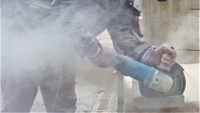Across the globe it’s estimated that 1 in 10 people will become sick due to respiratory hazards encountered in the workplace annually, according to The American Journal of Respiratory Care and Medicine. Respiratory hazards can occur in several forms in the workplace and can include dust, solvents, or lack of oxygen. October is recognized as Healthy Lung Month, and with respiratory protection being one of the most commonly cited violations of OSHA standards when conducting a jobsite inspection, worker education and following preventative health practices is crucial.
Harmful dusts
In many occupations, dust in the workplace is unavoidable. A seemingly harmless irritant, the inhalation of some dusts in high concentrations can result in long lasting health issues for individuals. Examples of dust found on a job can include anything from toxic mineral and fibrous dusts such as free crystalline silica and asbestos, to metallic and biohazard dusts. Exposure to dust on a jobsite can come from doing tasks such as drywall finishing, cutting tile, masonry, and demolition work. Topically, some dusts contain irritants which can cause a reaction to the skin and eyes, such as itchiness, dryness, and redness. Similarly, individuals may experience breathing problems such as coughing or wheezing.
Depending on the size and type of particulate matter, long term exposure can impact the respiratory system in a number of ways. While larger dust particles can be blocked by nose hair and the mucus lining in our airways, smaller dust may contain microscopic solids or liquid droplets that have the ability to penetrate deep into the lungs. Many lung irritants have been shown to cause pleural thickening, the development of scar tissue on the lining of the lungs. Having no cure, patients typically suffer from chest pain and difficulty breathing. This progressive disease can be an early sign of serious illnesses such as mesothelioma and lung cancer, and should be monitored if symptoms worsen.
Solvent vapors
The National Institute for Occupational Safety and Health (NIOSH) estimates that nearly 10 million workers may be exposed to organic solvents in the workplace daily. Solvents are commonly used in products such as paints, adhesives, glues, spray coatings, and plastics. Industrial solvents are often mixtures of several individual substances, which can make them extremely toxic in humans. With almost 50 million tons of solvents produced in the US annually, there has been a push for solvent-based products to be swapped with less hazardous materials.
Those who are exposed to solvents will feel the effects almost immediately after inhalation, as vapors rapidly move into the bloodstream. Individuals can experience headaches, dizziness, nausea, breathing difficulties, and even become unconscious from fumes. In low volumes, these symptoms will usually subside quickly and without any permanent damage. However, repeated exposure and high concentrations of solvents can lead to liver, kidney, and throat damage. As both a neurotoxin and carcinogen, these volatile compounds can damage the central nervous system and lead to an increased risk of developing cancer.
Oxygen deficiency and confined spaces
Confined spaces, which can include areas such as manholes, crawl spaces, pipes, and tanks, are not designed for continuous use as they are hard to exit in the event of an emergency. These spaces can be significantly more hazardous than other elements of a jobsite because individuals are at risk of electrocutions with higher levels of humidity, explosions, and asphyxiation in a constricted area. If an accident were to happen where an individual becomes unconscious or trapped, self-rescue by the worker is more difficult because a small space can be hard to quickly get out of.
A trained and certified professional should assess existing, as well as determine all potential hazards, prior to workers entering a confined space. This can include testing viable amounts of oxygen levels, ensuring there are no toxic or flammable gases in the area, and subsequent ventilation equipment is present and working correctly.
Preventing harm
Employers must be transparent about any type of hazard that can put their employees in harm's way. The Hazard Communication Standard (HCS) regulated by OSHA requires employers to evaluate any conditions in which workers can be at risk of toxic chemical exposure, as well as the effects of such exposure. The HCS helps employers design and implement these protective programs for employees who could be exposed to hazardous chemicals, however, it’s also pertinent for employees to participate in these training programs so that they know how to actively and effectively protect themselves.






